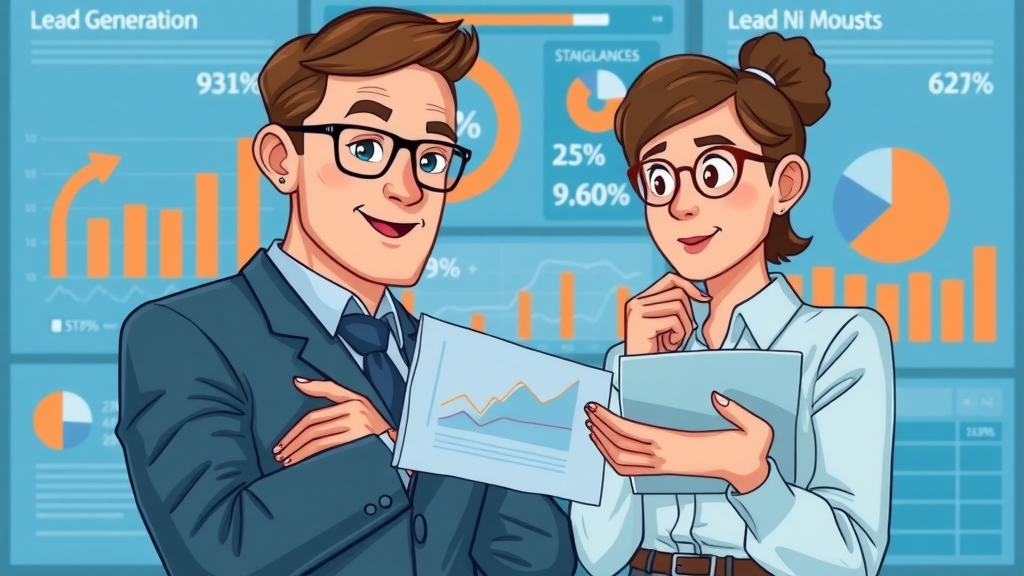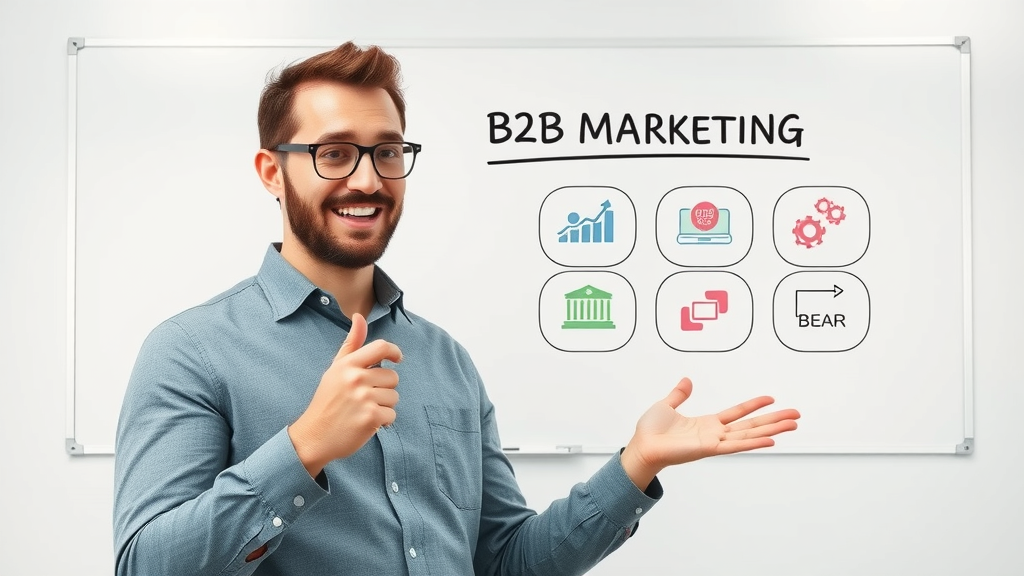Did you know over 68% of B2B businesses struggle to generate quality leads ? It’s a staggering figure, and yet, the most successful companies make it look effortless. What’s the difference? Top marketers have a playbook of lead gen tactics, data insights, and high-converting systems they rarely discuss openly. If you’re ready to stop spinning your wheels and start fueling your pipeline with qualified leads , let’s reveal the B2B lead generation secrets that can truly set your brand apart.

Unlocking the Power of B2B Lead Generation: Surprising Stats & Untold Tactics
- Discover why over 68% of B2B businesses struggle with quality lead generation—and how you can avoid their mistakes.
- Understand critical factors driving exceptional b2b lead generation and actionable steps top marketers keep under wraps.

B2B lead generation is not just about collecting business cards or filling your CRM with contacts. It’s about attracting, engaging, and converting the right decision-makers and turning them into loyal customers. In fact, over two-thirds of B2B firms confess to struggling with quality lead generation . Why? The landscape is fiercely competitive, the buyers are informed, and the tactics that worked yesterday might already be obsolete. To win consistently, you need to understand which strategies deliver qualified leads and which just create noise. Let's uncover why quality matters more than volume, and which steps you can take right now to secure an edge competitors won’t advertise.
Essential Insights: What You’ll Gain from Mastering B2B Lead Generation
- Learn how to build a scalable sales lead pipeline using proven B2B lead generation strategies
- Explore advanced lead gen tools, tactics, and content marketing techniques for generating qualified leads
- Discover how to leverage social media, landing pages, and email marketing in your demand generation process

- Access real-world case studies, statistics, and expert perspectives to boost lead generation performance
Becoming a master in B2B lead generation means unlocking opportunities for sustainable business growth. You’ll not only discover how to build a scalable sales lead pipeline but also how to use robust frameworks for filtering out unqualified leads so your sales team focuses on real opportunities. This article arms you with proven B2B lead generation strategies, dives into the latest content marketing techniques, and highlights the importance of platforms like social media and landing page optimization. You’ll gain actionable insights into CRM implementation, automation, analytics, and even advanced tactics like buyer intent data , setting you on the fastest track to more sales leads.
The Anatomy of B2B Lead Generation: How Today’s Top Brands Drive Sales Leads
Understanding Lead Gen: The Basics and Beyond
- Key definitions: sales lead, lead generation, demand gen, and b2b lead generation
- Sales leads vs. qualified leads: How top brands differentiate for high ROI
“According to HubSpot, 61% of marketers say generating traffic and leads is their top challenge.”

At its core, b2b lead generation is the process of identifying, attracting, and nurturing potential business clients who are most likely to convert into paying customers. Here’s the honest truth: Not every sales lead is a quality lead . Top-performing brands set themselves apart by creating frameworks to distinguish between raw prospects, sales leads, and qualified leads that have a higher probability of entering the sales funnel and purchasing. In practice, demand gen goes hand-in-hand with lead generation, laying the groundwork by creating market interest before capturing data through landing pages, email marketing, and social media campaigns. When executed properly, this approach results in a predictable pipeline of high-value accounts.
Companies leading the pack in b2b lead generation invest time in understanding their ideal customer profiles, using buyer data and digital touchpoints to track progress. They continually refine their marketing campaigns based on analytics, using tools such as CRM, marketing automation, and behavioral scoring models. Ultimately, the goal is not just to generate leads , but to qualify and nurture them into successful, revenue-generating relationships for your business.
The Modern B2B Lead Generation Process: Step by Step
- Mapping the generation process: from attracting prospects to converting them into quality leads
- Aligning your marketing campaign and sales teams for seamless lead conversion
The modern generation process for B2B lead generation starts with targeted attraction—drawing in prospects using SEO, social media, or content marketing. Next, landing pages and forms capture crucial contact information . But that’s just the beginning: integrating your marketing campaign efforts with your sales team ensures no promising sales lead slips through the cracks. Effective nurturing, often through segmented email marketing and lead scoring, enables efficient conversion into qualified leads . Smart brands continually monitor the process, optimizing based on data and evolving market needs, ensuring that each step of the pipeline feeds into long-term customer acquisition and retention.
High-performance organizations map every detail, from awareness to conversion, aligning content for each stage of the sales funnel . The best teams share data across the organization, enabling feedback between marketing and sales to enhance future lead gen campaigns. This agile approach, built on feedback, testing, and analytics, differentiates the average from the extraordinary in the realm of b2b lead generation.
Core Strategies for Effective B2B Lead Generation: Proven Tactics for Sales Growth
Content Marketing and B2B Lead Generation: Building Authority and Trust
- Types of high-performing content for generating sales leads
- SEO-driven content strategies to boost lead generation
- Case Study Table: Content Tactics vs. Lead Quality
Content Tactics vs. Lead Quality Content Type Average Conversion (%) Notable Example Blog Posts 2.9% Company X Whitepapers 5.2% Company Y Webinars 7.1% Company Z

Content marketing remains the backbone of B2B lead generation. Businesses that consistently produce high-value blog posts, whitepapers, and webinars see a measurable lift in qualified leads . According to recent research, webinars boast the highest conversion rate, reaching up to 7.1% —well above many other formats. The reason is simple: educational, trust-building content not only demonstrates your expertise but also encourages potential customers to provide their contact information . But there’s more. By harnessing SEO-driven strategies, your content is found by potential leads actively searching for solutions, pushing your brand in front of key decision makers at the optimal time.
Authority is built through consistent delivery of insightful, actionable resources, from downloadable guides to rich media product demos. Top marketers amplify content reach through strategic promotion across social media and by nurturing warm leads with targeted follow-ups based on content engagement. The best brands also implement A/B testing with landing pages tied to content offers, optimizing every stage for maximum conversion rate and ROI. When you view content marketing not as a cost, but as an investment in sustained, high-quality lead flow, it becomes the cornerstone of revenue growth.
Mastering Social Media for Lead Gen Success
- Which channels generate qualified sales leads in B2B: LinkedIn, Twitter, and beyond
- Optimizing paid and organic social media campaigns to maximize lead generation
“79% of B2B marketers rate LinkedIn as the best platform for generating qualified leads.”

In the world of b2b lead generation , social media is more than just a brand awareness tool—it’s a strategic pipeline for qualified leads . Platforms like LinkedIn dominate, with nearly 80% of B2B marketers rating it the top channel for acquiring viable business prospects . Paired with targeted advertising, organic posts, and group engagement, brands can develop meaningful relationships with potential clients long before a sales rep reaches out. But success isn’t limited to LinkedIn. Savvy marketers use Twitter, industry forums, and even niche platforms to promote high-performing content and direct leads to optimized landing pages.
To maximize ROI, blend paid and organic efforts and always retarget those who engage with your brand. Matching ad messaging with landing page copy, offers, and user intent increases conversion rate and helps you stand out in a noisy feed. Leverage analytics to track which channels and campaigns generate the highest volume of quality leads and double down on those tactics. Don’t overlook the power of social media listening and engagement for connecting with decision-makers at critical buying stages in your business funnel.
Landing Pages and Conversion Optimization in B2B Lead Generation
- Best practices for landing page design: Form fields, trust signals, and calls to action
- Case example: How a single change increased lead gen rates by 30%

Landing page optimization is a non-negotiable in lead generation . High-performing landing pages utilize simple forms, clear headlines, and visual cues that guide visitors toward action. Implementing trust signals—like testimonials, security badges, and clear privacy messaging—has been shown to dramatically increase conversion rate . For example, when Company Y reduced its upper funnel form fields from five to three and added key trust badges, lead gen rates jumped by 30% overnight. Every landing page should reinforce your value proposition and make it effortless for potential leads to share their contact information.
Smart B2B brands don’t just set and forget. They run A/B tests on headlines, offers, and CTAs, analyze heatmaps for user behavior, and continually optimize based on results. The goal is to reduce friction, eliminate confusion, and create a seamless path that guides targeted traffic from ad or content to form fill and, ultimately, a highly qualified sales lead. When every landing page becomes a conversion engine, your b2b lead generation compounds with every incremental improvement.
Email Marketing Campaigns That Fuel B2B Lead Generation
- Crafting irresistible subject lines and offers that generate leads
- Nurturing qualified leads through segmentation and automation

Email marketing remains the unsung hero of B2B lead generation. Compelling subject lines, personalized offers, and hyper-relevant content are essential to spark engagement and entice recipients to click through to your landing pages. Segmentation—targeting by role, industry, and sales funnel stage—enables you to nurture qualified leads rather than fatigued inboxes. When combined with automation, you can deliver timely messages, trigger product demos or case studies based on user behavior, and maintain consistent contact without overwhelming your team.
True B2B email success comes from mapping the generation process —ensuring each campaign is aligned with the needs of your ideal customer and delivers genuine value at every stage. Use analytics to monitor open and click-through rates, letting data guide future subject line creation, content offers, and follow-ups. Brands that continuously optimize their messaging reap the rewards of higher response rates, warmer leads, and—most importantly—a greater number of sales leads that convert.
Demand Generation vs. Lead Gen: Understanding the Differences and Synergies
Demand Generation: Creating Market Interest for Sustainable Growth
- How demand gen supports and amplifies B2B lead generation
- Measuring demand gen impact: Key metrics for success
Demand generation is all about creating sustained interest in your product or service throughout the market. While lead generation focuses on capturing specific potential leads, demand gen campaigns are designed to build awareness, educate your audience, and create excitement for your solutions. The result? When prospects are ready to buy, they already know and trust your brand. Metrics like engagement rates, web traffic growth, and content downloads serve as vital KPIs to measure demand generation’s impact. Ultimately, demand gen fuels the top of the sales funnel and sets the stage for intent-driven b2b lead generation .
Leading companies unify their demand generation and lead gen efforts for maximum market penetration. By mapping content and messaging to each step in the buyer journey, you establish a feedback loop that continuously sharpens your approach, resulting in higher quality leads and accelerated sales cycles.
When to Focus on Lead Generation vs. Demand Generation Strategies
- Evaluating your growth stage, target audience, and pain points

The most effective B2B marketers know when to double down on lead generation tactics and when to scale their demand gen efforts. If you operate in a highly competitive niche with informed buyers, growing awareness and authority through demand gen should be your priority. As your sales team builds a healthy inbound pipeline, shift focus to nurturing and qualifying each sales lead for tailored conversion. Your growth stage, product complexity, and customer pain points all influence where to invest resources. For established brands, synchronizing both approaches maximizes coverage, ensuring you capture market share and convert the highest quality leads.
Regularly audit your campaigns, sales funnel progression, and lead metrics to detect bottlenecks and opportunities. Smart marketers adjust their ratio of demand gen to lead generation strategies throughout the business cycle, optimizing for the business’s immediate and future growth objectives.
Top Pain Points in B2B Lead Generation—and How to Overcome Them
Pinpointing and Solving Lead Quality Issues
- Identifying qualified leads versus unqualified leads with actionable frameworks
- Filtering for B2B sales leads that propel business growth
Lead quality is a recurring challenge for B2B teams. Too often, a high volume of potential leads enters the pipeline but only a fraction is truly sales-ready. Overcoming this requires actionable frameworks for qualification—such as BANT (Budget, Authority, Need, Timeline) or more advanced predictive scoring based on behavioral data and firmographics. Segmenting your inbound traffic and using precise criteria to separate qualified leads from unqualified prospects ensures your sales team spends time on opportunities that matter. This focus not only boosts conversion rate, but also shortens sales cycles and improves ROI—a win for both marketing and sales.
Equally important is ongoing collaboration between teams to review the attributes and buying patterns of successful clients. Identifying patterns among your best customers will sharpen your future lead sourcing initiatives, helping to consistently propel your business towards growth.
Overcoming Common Barriers: From Budget to Technology
- How to align tech, teams, and budget for maximum b2b lead generation results
Budget constraints, siloed teams, and outdated technology are among the biggest pain points in B2B lead generation. Leading brands prioritize investing in solutions that integrate marketing automation, CRM, and analytics for seamless collaboration and measurement. They regularly upskill team members and host cross-functional workshops to break down silos between marketing and sales. Technology is selected for its ability to scale with the business and provide actionable insights—not just for vanity metrics. Regular alignment meetings and shared KPIs further keep everyone accountable for lead gen outcomes.
Overcoming these barriers demands a mindset of adaptation. High-growth teams embrace new channels, experiment with innovative content formats, and invest in solutions that automate repetitive tasks. The payoff? Greater agility, increased productivity, and remarkable results in sales lead volume and conversion quality.
Optimizing the Lead Generation Process: Continuous Improvements for Elite Marketers
- Testing, measuring, and iterating on your lead generation campaigns
- Real-world improvement checklist for higher b2b lead gen ROI

Elite marketers never settle. Optimization is a continuous cycle involving rigorous testing, real-time measurement, and consistent iteration of campaigns. A/B test everything from messaging and offers to form lengths and landing page layouts. Use analytics to isolate what’s working, and don’t hesitate to pivot away from underperforming tactics. Here’s a high-impact checklist for driving higher B2B lead gen ROI:
- Audit current funnel and identify leaky stages
- Test new content types and promotional channels
- Segment audiences for personalized nurturing
- Automate repetitive processes to free up resources
- Regularly update buyer personas and qualification criteria
- Align sales and marketing KPIs for shared accountability
By relentlessly measuring, optimizing, and learning, you give your B2B lead generation engine the best chance to outperform expectations, year after year.
People Also Ask: Expert Answers to Top B2B Lead Generation Questions
What is a B2B lead generation?
- In-depth definition, examples, and why b2b lead generation matters for modern businesses.
B2B lead generation refers to all processes of attracting and capturing the interest of business decision-makers who might eventually become buyers. It could involve anything from inviting audiences to a webinar, offering a downloadable guide, or following up after a product demo. Effective lead gen gives businesses a steady pipeline of prospects to nurture, enabling them to target their sales and marketing efforts with strategic precision and maximize overall revenue.
What are the 4 types of B2B marketing?
- Analyze product-centric, service-centric, channel-centric, and customer-centric approaches for b2b lead generation.

The four types of B2B marketing are:
Product-centric (focused on the features and specifications), Service-centric (emphasizing solutions and ongoing support), Channel-centric (leveraging distributors, resellers, or partners for reach), and Customer-centric (tailoring campaigns and offers to specific customer profiles and industries). Each approach requires a unique blend of tools and content to generate the most qualified leads —and the best marketers blend these strategies for holistic lead gen.
What is a B2B lead generation specialist?
- Roles, skillsets, and impact on efficient b2b lead generation processes and sales lead conversion.
A B2B lead generation specialist is an expert focused on sourcing, engaging, and qualifying business prospects for the sales team. They deploy a mix of strategic outreach, content marketing, and digital campaigns to consistently fill the sales pipeline with quality leads . Proficiency in CRM, automation tools, and analytics is key, as their work impacts the efficiency and success of sales lead conversion and overall growth.
What is your favorite way to generate B2B leads?
- Expert tips, creative approaches, and unconventional b2b lead generation methods from industry leaders.
While every brand is unique, many experts agree that multi-channel nurturing provides the highest ROI in B2B lead generation. Creative approaches such as running virtual events, hyper-personalized email campaigns, and proactive social selling (especially on LinkedIn) consistently rank as favorites among industry leaders. Ultimately, the best way to generate leads is to offer genuine value, deliver targeted messages to the right people at the right time, and always test new ideas alongside tried-and-true strategies.
Expert-Recommended Tools and Resources for B2B Lead Generation
- List: Top rated b2b lead generation software and platforms
- CRM solutions, automation tools, and analytics suites for high-efficiency sales leads management
- Buyer intent data and lead enrichment tools that uncover quality leads

The right stack of B2B lead generation tools amplifies your capacity to attract, qualify, and convert more sales leads . Industry favorites include LinkedIn Sales Navigator, HubSpot, Marketo, ZoomInfo, and Leadfeeder. For CRM and pipeline management, Salesforce and Pipedrive are commonly recommended, while tools like Outreach, Mailchimp, and ActiveCampaign streamline automation and nurture workflows. To pinpoint buyer intent and enrich prospect data, consider tools such as Bombora, Clearbit, and Lusha.
Integrating your technology platforms ensures data flows smoothly, giving your sales team access to up-to-date contact info while marketing gets clear attribution for what accelerates growth. The right tools empower your organization to scale, iterate quickly, and always stay one step ahead of competitors.
Boost Your Results: Actionable Steps to Transform Your B2B Lead Generation Strategy Today
- Step-by-step plan: Audit your current lead gen efforts
- Prioritize channels and content for immediate impact in sales lead conversion
- Test, measure, and optimize using the frameworks covered above for sustained b2b lead generation growth
“Success in b2b lead generation isn’t about luck; it’s about using the right systems at the right time.”
Take Actionable Steps:
- Audit your existing lead generation campaigns and funnel performance
- Identify your highest performing content and social channels—double down on what’s working
- Refine and split-test landing pages to increase conversion rate
- Segment email lists and automate nurture sequences for consistent follow-up
- Regularly realign marketing with sales for shared goals and data-driven improvements
- Adopt at least one advanced tool—like an intent data platform—to uncover quality leads you never knew existed
- Repeat the process quarterly to ensure you stay ahead of changing market conditions
Frequently Asked Questions: B2B Lead Generation
-
What’s the best channel for b2b lead generation in 2024?
LinkedIn remains the top channel for most B2B brands, but success often comes from a well-balanced mix of SEO content, targeted social, and email marketing. Evaluate where your ideal customers spend time and invest most heavily there. -
How do I measure qualified leads vs. unqualified leads?
Qualified leads are typically measured by fit (demographics, firmographics) and intent (actions taken, content consumed). Use defined frameworks and analytics tools to ensure your pipeline is filled with opportunities primed for conversion. -
What are common mistakes in b2b lead generation?
Common errors include targeting too broad an audience, failing to align sales and marketing, ignoring data, and using generic landing pages rather than tailored experiences. Avoid hype—test everything and use data-driven decision making. -
How can I improve landing page conversions for sales leads?
Focus on one primary call-to-action, minimize form fields, add trust elements, and ensure your page matches the ad or email that sent the visitor. Regularly A/B test layouts and offers for stepwise improvement.

Ready to Transform Your B2B Lead Generation? Take the Next Step
- Call us at (385) 469-1869 or email at info@solu4u.com today to unlock the secrets of sales lead growth through next-level b2b lead generation.
Take bold action—implement these B2B lead generation secrets, optimize relentlessly, and watch your sales pipeline surge with highly qualified leads.
Sources
- https://blog.hubspot.com/marketing/b2b-lead-generation-strategies
- https://www.marketo.com/lead-generation/b2b-lead-generation/
- https://www.linkedin.com/business/marketing/blog/b2b-marketing/b2b-marketing-statistics
- https://www.salesforce.com/resources/articles/b2b-lead-generation-techniques/
- https://www.brighttalk.com/webcasts/43/330271
To deepen your understanding of B2B lead generation, consider exploring the following authoritative resources:
- “B2B Lead Generation: Types, Process, & Strategies” ( salesfocusinc.com )
This comprehensive guide delves into various lead generation types, outlines the step-by-step process, and offers strategic insights to enhance your lead acquisition efforts.
- “21 B2B Lead Generation Tactics” ( outbrain.com )
This article presents a diverse array of tactics, including influencer marketing and account-based marketing, providing actionable strategies to effectively generate and nurture B2B leads.
By integrating the insights from these resources, you can refine your lead generation strategies and drive meaningful business growth.
 Add Row
Add Row  Add
Add 




Write A Comment